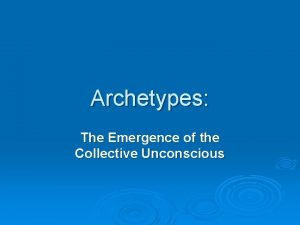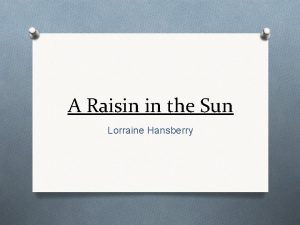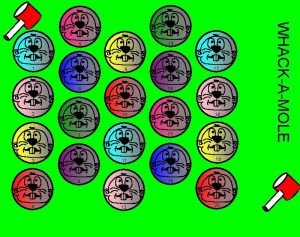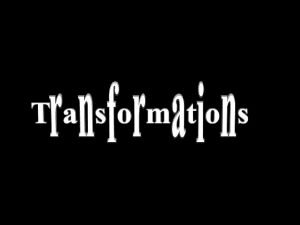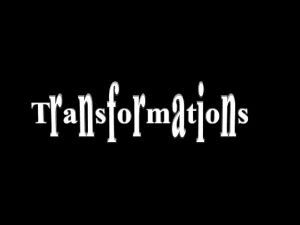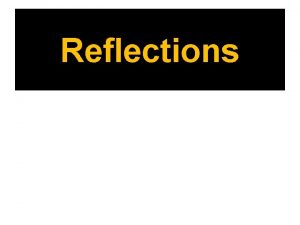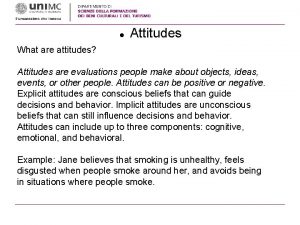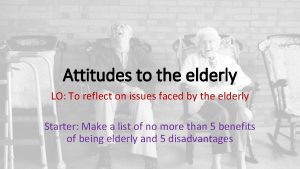Language Attitudes Ultimately attitudes to language reflect attitudes










- Slides: 10

Language Attitudes “Ultimately attitudes to language reflect attitudes to the users and the uses of language…” “The is nothing intrinsically beautiful or correct about any particular sound. ” “They develop attitudes towards languages which reflect their views about those who speak the languages, and the contexts and functions with which they are associated. ” Holmes, Janet. 2013. An Introduction to Sociolinguistics, 4 th edition. London: Pearson, pp. 409 -410. 1/10

Examples of Strong Views towards Languages Language riots in Belgium and India Getting rid of English road signs in Wales Change in attitudes towards English and French in Quebec Long delay in developing a script for written Somali because of competing prestige forms (Roman vs. Arabic alphabets) Holmes, Janet. 2013. An Introduction to Sociolinguistics, 4 th edition. London: Pearson, 2/10 pp. 410 -411.

Ratings of RP Speakers vs. Regional-Accent Speakers more intelligent more industrious more self-confident more determined more communicative effectiveness more social status more general pleasantness often taken more seriously more persuasive Holmes, Janet. 2013. An Introduction to Sociolinguistics, 4 th edition. London: Pearson, p. 416. 3/10

Local Accents and Covert Prestige “On the other hand, while RP tends to be rated highly on the status dimension, as in Britain, local [New Zealand] accents generally score more highly on characteristics such as friendliness and sense of humour, and other dimensions which measure solidarity or social attractiveness. ” Holmes, Janet. 2013. An Introduction to Sociolinguistics, 4 th edition. London: Pearson, p. 417. 4/10

Discrimination “I have tried to show that the reasons people condemn vernacular forms are attitudinal, not linguistic. Children who use vernacular forms are not disadvantaged by inadequate language. They are disadvantaged by negative attitudes towards their speech— attitudes which derive from their lower social status and its associations in people's minds. ” Holmes, Janet. 2013. An Introduction to Sociolinguistics, 4 th edition. London: Pearson, p. 420. 5/10

A Note on Methodology 1. Societal treatment 2. Direct measures 3. Indirect measures Holmes, Janet. 2013. An Introduction to Sociolinguistics, 4 th edition. London: Pearson, pp. 420 -423. 6/10

A Note on Methodology 1. Societal treatment Observing use in public domain Examining government documents about status Educational document Employment advertisements Dialect representation in novels Cartoons (societal stereotypes) Newspapers, books Holmes, Janet. 2013. An Introduction to Sociolinguistics, 4 th edition. London: Pearson, pp. 420 -421. 7/10

A Note on Methodology 2. Direct measures Ask direct questions about attitudes Written questionnaires (possible large scope) Well-known problems with questionnaires Holmes, Janet. 2013. An Introduction to Sociolinguistics, 4 th edition. London: Pearson, pp. 421 -422. 8/10

A Note on Methodology 3. Indirect measures Matched guise technique (less in your fact) Holmes, Janet. 2013. An Introduction to Sociolinguistics, 4 th edition. London: Pearson, pp. 422 -423. 9/10

Sociolinguists’ Potential Contribution to Society Educate people in society about variation and varieties In the classroom—gaining acceptance for vernacular language Testing Holmes, Janet. 2008. An Introduction to Sociolinguistics, 3 rd edition. Harlow, England: Pearson-Longman, p. 420 ff. 10/10
 Whirlpool archetype examples
Whirlpool archetype examples Transition words for paragraphs
Transition words for paragraphs The young man from the provinces archetype examples
The young man from the provinces archetype examples Heaven vs hell archetype
Heaven vs hell archetype Loyal retainer archetype
Loyal retainer archetype Innate wisdom vs. educated stupidity
Innate wisdom vs. educated stupidity Mama's plant symbolism
Mama's plant symbolism As ecological development proceeds, a biological community
As ecological development proceeds, a biological community Haven vs wilderness examples
Haven vs wilderness examples The castle archetype examples
The castle archetype examples Does language reflect intelligence
Does language reflect intelligence





